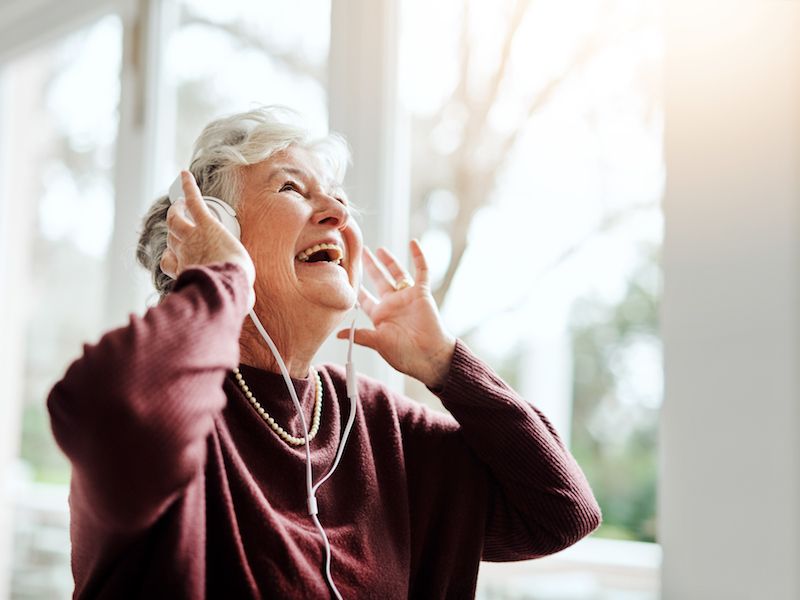
Noise-related loss of hearing doesn’t just affect people who work in loud surroundings, like construction workers or heavy metal roadies. It doesn’t even have to be work-related, leisure-related noise exposure can be dangerous, also. What type of exposure are we dealing with? Music, gaming, streaming video or anything else that you would listen to through earbuds or headphones.
You may not think your smartphone or tablet can go that loud. The ordinary pain threshold for human hearing is around 150 db which is well within the range of these devices. This is the volume at which noise begins to literally cause pain in your ears. So what can you do to safeguard against this type of noise-related hearing loss?
The volume level here is important. Listen with the volume at or below 60% for no more than 60 minutes at a stretch (how long you listen for also makes a difference), this is known as the 60/60 rule.
Your Hearing Aids Can be Set up For Listening to Music
If you have hearing aids, you’re more than likely streaming your mobile device right to your hearing aids, so make sure the volume is not too loud or that you’re not trying to drown out other noises with your music. Additionally, ask us about how to best listen to music. If you’re a musician or someone who loves music you might have noticed that most hearing aids are created to sharpen the clarity of voices…not necessarily music. While enjoying music, we can most likely make various adjustments to help improve the sound quality and decrease the feedback.
What Are The Right Headphones For You?
If you don’t own hearing aids, there are lots of choices for purchasing headphones. It might be a matter of personal choice, but there are some things you will want to consider there as well.
Headphones That go Over The Ears
While the foam-covered earpieces that was included with your old Walkman are mostly no longer used, over-the-ear headphones have had a resurgence. Often unexpectedly costly, they feature a large variety of color options and celebrity endorsements, and of course, superior sound quality. And unlike those little foam pads, these cover the whole ear, stopping outside sounds.
Main-stream wisdom is that these are safer than in-ear headphones because the source of the sound is further from your eardrum. But because the speakers are larger they are usually capable of much higher volume. Also, noise-canceling will probably help you ignore the crying baby on your flight, but in other circumstances, it can block sounds you need to hear (such as a honking car). But on the positive side, you won’t need to compete with outside noise so you can listen to your music at lower levels.
Earbuds
The normal earbuds that come with devices like iPhones are much maligned for their poor sound quality, although lots of people still use them because hey, they came with the phone. Moreover, with newer models that don’t have a headphone jack, sticking with Apple’s earbuds can just be easier.
Earbuds also don’t block out noise so the downside is, you have a tendency to turn up the sound level. Again, though it’s often said that earbuds are problematic because you put them into your ear so their speakers are very close to your eardrum, actually volume is the biggest problem.
Earbuds That Block Outside Sound
More comfortable than regular earbuds, models that have a round rubber tip are the choice of many people because they help obstruct outside sound. The rubber molds to the shape of your ear, producing a seal that blocks other sounds from entering. Not to sound like a broken record, but these have the same drawbacks as the other two (volume is the main problem), as well as carrying the same caution as over-the-ear headphones (they can block out warning sounds). Needless to say, these won’t work for you if you wear hearing aids.
Several pairs may need to be evaluated before you find headphones that are correct for you. Depending on what you’re most often using them for talking on the phone, say, versus listening to music, you’ll have unique acoustic requirements. The essential thing is to find headphones that make it comfortable for you to listen at a safe volume.
How to Make Sure Your Hearing is Safeguarded
How can you be sure it’s safe? There’s an app for that…If you have a smartphone, you can download the National Institute for Occupational Safety and Health’s free Sound Level Meter app. You can get different apps, but research has discovered that the accuracy of these other apps is hit-and-miss (also, for unknown reasons, Android-based apps have been shown less precise). That motivated NIOSH to create their own app. The app lets you measure outside sounds, but sounds coming from your device’s speakers can also be measured, this means, the true volume of what’s going to your ears. You have to do a little work, but putting in place these types of protective measures can help protect your hearing.
